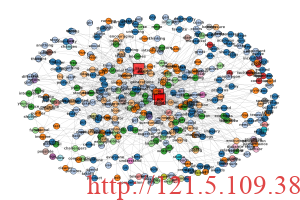提出问题
最近有些文档想要可视化展示效果,奈何一些软件需要付费,且展示的效果不尽人意。因此,结合之前做过的一些可视化研究,利用python重写了相关语义网络可视化效果。
解决问题
原理:通过计算共现次数,保留共现次数高的(这里是>=4次)。
import docx
import nltk
from nltk import word_tokenize, FreqDist
from nltk.corpus import stopwords
import networkx as nx
import matplotlib.pyplot as plt
def read_word_file(file_path):
# Open the Word document
doc = docx.Document(file_path)
# Store the text content
text = ""
for para in doc.paragraphs:
text += para.text + " "
return text
def preprocess_text(text):
# Tokenize the text
words = word_tokenize(text.lower())
# Remove stopwords, punctuation, and non-alphabetic words
stop_words = set(stopwords.words('english'))
words = [word for word in words if word.isalpha() and word not in stop_words]
return words
def calculate_co_occurrence(words):
# Calculate co-occurrence relationships between words
co_occurrence = {}
window_size = 3 # Adjust the window size as needed
for i, word in enumerate(words):
for j in range(1, window_size + 1):
if i + j < len(words):
next_word = words[i + j]
if word != next_word:
key = (word, next_word)
co_occurrence[key] = co_occurrence.get(key, 0) + 1
return co_occurrence
def create_semantic_network(co_occurrence):
# Remove co-occurrence relationships with a count of 1
co_occurrence = {key: value for key, value in co_occurrence.items() if value > 3}
# Create a weighted graph with co-occurrence counts as edge weights
graph = nx.DiGraph()
for (word1, word2), count in co_occurrence.items():
graph.add_edge(word1, word2, weight=count)
return graph
def cluster_graph(graph):
# Perform clustering on the graph using Louvain method
clustering = nx.algorithms.community.modularity_max.greedy_modularity_communities(graph)
clusters = {node: cluster_id for cluster_id, cluster in enumerate(clustering) for node in cluster}
return clusters
def visualize_semantic_network(graph, central_words, clusters):
# Draw the semantic network graph with clustering information
plt.figure(figsize=(12, 8))
pos = nx.spring_layout(graph, k=0.7, seed=42) # Adjust 'k' for node dispersion
# Extract edge weights for edge labels
edge_labels = {(word1, word2): graph[word1][word2]['weight'] for word1, word2 in graph.edges()}
# Determine node colors based on clusters
node_colors = [clusters[node] for node in graph.nodes()]
cmap = plt.get_cmap('tab20', max(node_colors) + 1)
nx.draw(graph, pos, with_labels=True, node_size=300, node_color=node_colors, cmap=cmap,
font_size=10, font_weight='bold', width=0.5, edge_color='gray', arrows=True, arrowstyle='->',
connectionstyle='arc3,rad=0.2', alpha=0.7)
# Draw the custom nodes (central words) with larger size and red color
custom_nodes = [node for node in central_words if node in graph.nodes()]
for node in custom_nodes:
graph.add_node(node) # Add central word to the graph if it's not already present
nx.draw(graph, pos, with_labels=True, node_size=1000, node_color='red', cmap=cmap,
font_size=10, font_weight='bold', width=0.5, edge_color='gray', arrows=True, arrowstyle='->',
alpha=0.7, nodelist=custom_nodes, node_shape='s')
# Draw edge labels (co-occurrence counts)
nx.draw_networkx_edge_labels(graph, pos, edge_labels=edge_labels, font_size=8)
# Save the plot
plt.savefig('semantic_network.png', dpi=300)
plt.show()
# Rest of the code remains the same
def main():
file_path = "./data/xxx.docx" # Replace with the actual path of your Word document
# Read the Word document
text = read_word_file(file_path)
# Preprocess the text
words = preprocess_text(text)
# Calculate co-occurrence relationships between words
co_occurrence = calculate_co_occurrence(words)
# Find the central words (the top three most frequent words)
central_words = [word for word, _ in FreqDist(words).most_common(3)]
# Create a semantic network graph
graph = create_semantic_network(co_occurrence)
# Perform clustering on the graph
clusters = cluster_graph(graph)
# Visualize the semantic network graph with the top three central words marked in red and clustering information
visualize_semantic_network(graph, central_words, clusters)
if __name__ == "__main__":
main()

文章评论